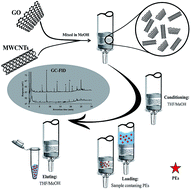Efficient extraction of phthalate esters with different polarities from seawater samples using multi-walled carbon nanotubes/graphene oxide nanosheets
Abstract
In this method, a new adsorbent composed of multi-walled carbon nanotubes (MWCNTs) and graphene oxide (GO) nanosheets was developed. The proposed adsorbent efficiently extracted six environmentally important phthalate esters (PEs) with a wide range of polarities in seawater samples. Compared to a separate application of MWCNTs and GO nanosheets as mini-columns, their simultaneous use as efficient adsorbents led to the extraction of the whole PEs via a synergistic effect. As shown by the results, 4 : 1 (MWCNTs : GO) was the optimum ratio of the adsorbent components. Among many solvents, the retained analytes were completely eluted from the mini-column by tetrahydrofuran and then analyzed using a gas chromatography-flame ionization detector. This method was successfully used in seawater samples without a need for the dilution of genuine water samples since the extraction recoveries of the PEs were not significantly affected. This was due to the strong adsorption of the analytes on the mentioned adsorbent in spite of the changes in water salinity up to 40 g L−1. The intra-day extraction recoveries showed a range of 83.2–98.2% with the relative standard deviations lower than 5.5% (n = 5) under optimized conditions. The limits of detection were calculated to be 0.036–1.41 μg L−1. After spiking the standard solutions in the seawater samples, the results of the proposed method were indicative of their high capabilities for the extraction and pre-concentration of PEs in environmental water samples.



 Please wait while we load your content...
Please wait while we load your content...